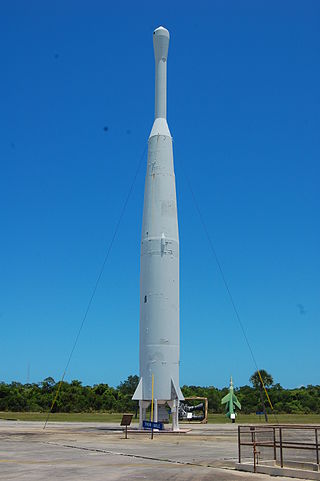
The Delta rocket family was a versatile range of American rocket-powered expendable launch systems that provided space launch capability in the United States from 1960 to 2024. Japan also launched license-built derivatives from 1975 to 1992. More than 300 Delta rockets were launched with a 95% success rate. The series was phased out in favor of the Vulcan Centaur, with the Delta IV Heavy rocket's last launch occurring on April 9, 2024.

The Thor-Able was an American expendable launch system and sounding rocket used for a series of re-entry vehicle tests and satellite launches between 1958 and 1960.

Thor-Agena was a series of orbital launch vehicles. The launch vehicles used the Douglas-built Thor first stage and the Lockheed-built Agena second stages. They are thus cousins of the more-famous Thor-Deltas, which founded the Delta rocket family. The first attempted launch of a Thor-Agena was in January 1959. The first successful launch was on 28 February 1959, launching Discoverer 1. It was the first two-stage launch vehicle to place a satellite into orbit.
Thor was a US space launch vehicle derived from the PGM-17 Thor intermediate-range ballistic missile. The Thor rocket was the first member of the Delta rocket family of space launch vehicles. The last launch of a direct derivative of the Thor missile occurred in 2018 as the first stage of the final Delta II.

Thorad-Agena was an American expendable launch system, derived from the Thor and Delta rockets.

The Delta E, or Thor-Delta E was an American expendable launch system used for twenty-three orbital launches between 1965 and 1971. It was a member of the Delta family of rockets.

The Thor-Ablestar, or Thor-Able-Star, also known as Thor-Epsilon was an early American expendable launch system consisting of a PGM-17 Thor missile, with an Ablestar upper stage. It was a member of the Thor family of rockets, and was derived from the Thor-Able.

The Thor-Delta, also known as Delta DM-19 or just Delta was an early American expendable launch system used for 12 orbital launches in the early 1960s. A derivative of the Thor-Able, it was a member of the Thor family of rockets, and the first member of the Delta family.

The Delta B, or Thor-Delta B was an American expendable launch system used for nine orbital launches between 1962 and 1964. A derivative of the Thor-Delta, it was a member of the Delta family of rockets.

The Delta D, Thrust Augmented Delta or Thor-Delta D was an American expendable launch system used to launch two communications satellites in 1964 and 1965. It was derived from the Delta C, and was a member of the Delta family of rockets.
The Delta J or Thor-Delta J was an American expendable launch system of the late 1960s. Only one was launched, with the Explorer 38 spacecraft. It was a member of the Delta family of rockets.

The Delta M or Thor-Delta M was an American expendable launch system used for thirteen orbital launches between 1968 and 1971. It was a member of the Delta family of rockets.

The Delta N or Thor-Delta N was an American expendable launch system used for nine orbital launches between 1968 and 1972. It was a member of the Delta family of rockets, and the last Delta to be given an alphabetical designation - subsequent rockets were designated using a four digit numerical code.

The Delta 1000 series was an American expendable launch system which was used to conduct eight orbital launches between 1972 and 1975. It was a member of the Delta family of rockets. Several variants existed, differentiated by a four digit numerical code. Delta 1000 was developed by McDonnell Douglas company in 1972.

The Delta 2000 series was an American expendable launch system which was used to conduct forty-four orbital launches between 1974 and 1981. It was a member of the Delta family of rockets, sometimes called Thorad Delta. Several variants existed, which were differentiated by a four digit numerical code. The Delta 1000, 2000 and 3000 series used surplus NASA Apollo program rockets engines for its first and second stages.

The Delta 3000 series was an American expendable launch system which was used to conduct 38 orbital launches between 1975 and 1989. It was a member of the Delta family of rockets. Several variants existed, which were differentiated by a four digit numerical code.

The Delta 5000 series was an American expendable launch system which was used to conduct an orbital launch in 1989. It was a member of the Delta family of rockets. Although several variants were put forward, only the Delta 5920 was launched. The designation used a four digit numerical code to store information on the configuration of the rocket. It was built from a combination of spare parts left over from earlier Delta rockets, which were being retired, and parts from the Delta II 6000-series, which was just entering service.
Intelsat III F-1 was a communications satellite intended to be operated by Intelsat. Launched towards geostationary orbit in 1968 it failed to achieve orbit.
















